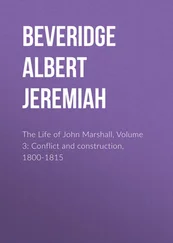1 ...6 7 8 10 11 12 ...19 Like a linguistic sign or a construction, these functions consist of a semantic component, which gives the general purpose of an expression like Magn, which expresses the meaning of intensification such as “intense(ly)” or “very”, Oper,for support verbs for performing or doing something, or Real,to add the meaning component of “realise” or “fulfil”. The form or phonological realisation is then the result of a lexical unit (argument) which selects based on lexical function a number of lexical expressions in order to form a phrase. Since neither more nor less is similar in meaning to exactly, it might be regarded as a kind of synonym or Syn-function according to Mel’čuk’s terminology (Mel’čuk 1998: 32–33). Similar to Cowie and Howarth’s “collocations with limited choice”, lexical functions are a more operationalised way of expressing an underlying level of meaning. At the same time, this concept also suggests that there could be two levels of meaning, or function, at work: one coming from the word meaning of the constituents themselves, the other from the more abstract combination of a specific item with a certain semantic representation . Just like in construction grammar, where, based on the assumption of inheritance relations, the general function of an argument structure construction influences the interpretation of individual constituents, such as the verb (Goldberg 2006: 19–44).
While Cowie and Howarth also explored the diagnostic potential of collocational proficiency and Mel’čuk focused on a more or less meta-lexicographic analysis, Franz-Josef Hausmann’s approach towards the co-occurrence of lexical items is more concerned with an adequate and comprehensive lexicographic description from an EFL point of view. With frequent learner mistakes and translational problems in mind, he regards institutionalisation and unpredictability as the central aspects of collocation. This emphasises a contrastive aspect and explicitly takes the native language of a learner into consideration. Accordingly, he defines collocations as “semi-preconstructed items within language, which are not a speaker’s ad hoc creation but retrieved from memory as a whole unit; the hearer would presumably perceive these as familiar.”5 (Hausmann 1984: 398–399). To Hausmann, these “typical, specific and characteristic relations between two words”6 (Hausmann 1985: 118) need to be given special attention within an EFL teaching context, since they enable the learner to communicate more fluently and in a natural, native-like way.

Figure 2.2: Typology of word combinations (based on Hausmann 1984 and Bartsch 2004: 38)
As can be seen in figure 2.2, Hausmann further distinguishes affine combinations from free combinations. However, to him these co-creations are less interesting within an EFL context, for they are built spontaneously and based on extralinguistic meaning restrictions: they are, so to say, unrestricted combinations of ordinary words. Counter-creations, on the other hand, stand at the most creative end of the spectrum of non-fixed word combinations. Since combinations like racy tone are, according to Hausmann, predominantly part of a certain more or less idiolectic style of an author. (Hausmann 1984: 399)
So again, do work and make a remark for Hausmann would qualify as collocations, since, to learners of English, there seems to be no concept-inherent reason why it should not be * make work 7 or * do a remark . On the contrary, in German for example Arbeit machen (lit.: make work) would be as accepted as Arbeit tun (lit: do work). As a result, this might cause confusion and represent a potential source of mistakes when transferring this concept from a German L1 to an English L2 context. Neither more nor less on the other hand consists of more than two words and would, therefore, be rejected on formal grounds, as within Hausmann’s framework there is only room for two constituents, a freely chosen base and its semantically dependent collocator . Both are linked via an arbitrary restriction on lexical choice. Other than word combinations, however, collocator and base, according to Hausmann, remain semantically independent (Hausmann 1984: 400–401). Scornful tone , on the other hand, might instead be considered a case of co-creation , since it could be well expected from an extralinguistic perspective that a concept like tone can be combined with the concept of a negative connotation, like scornful , but also (near)synonyms like condescending or dismissive are equally likely and possible. A combination like racy or Mozartean tone 8, however, could be regarded as a counter-creation, since the constituents’ co-occurrence cannot be predicted based on either extralinguistic experience or linguistic institutionalisation. Interestingly enough, Hausmann seems to presuppose that a certain degree of selectional restrictions exists even within counter-creations, since amongst all the examples he gives, there are none which are not decodable or which seem to be absolutely wrong or gibberish. This raises the question of where to draw the line, not only between collocation and creative counter-creation but also regarding the point where a word combination should be regarded as wrong, rather than creative.
Unfortunately, despite a clear notion of the elements which constitute a collocation, Hausmann’s concept as such remains rather vague. He does not explore the source of unpredictability, which might not only vary depending on the native language of a learner but also on very individual aspects like linguistic proficiency. This makes base and collocator useful terms for lexicographic purposes, but when it comes to learner-oriented cognitive aspects within the concept of collocation, the question remains whether it is indeed the collocator which needs to be remembered and therefore stored with the, rather free, base, or if it might be possible that the collocator as well contributes a kind of additional, more independent meaning perspective to the overall collocational meaning. Admittedly, Hausmann does not reject the idea of a kind of reverse analysis – from collocator to base – completely. However, he regards this as a linguistic research question, which lacks a sense of the learner’s reality (Hausmann 2007: 218). But as table 2.5 shows, knowing about meaning restrictions which are caused by the collocator can just as well prevent learners from non-native like utterances.
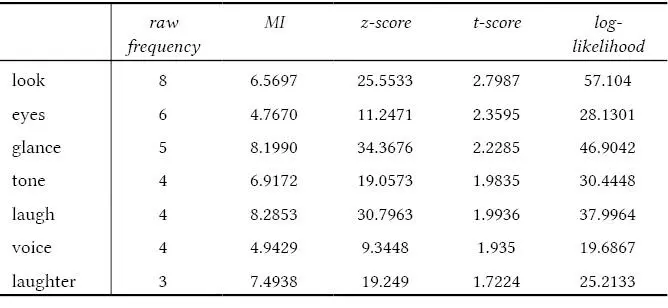
Table 2.5: List of noun collocates for scornful according to the BNC
[ scornful +N] for example, as in scornful tone , seems to combine with a semantically rather limited set of bases. Table 2.5 shows a list of all nouns which occur, with a span of four, more than three times within the BNC and have scornful as a premodification. All of them express either visual or auditory means of perception. Hence, there might be a kind of semantic pre-selection for the N-slot in [ scornful +N] which makes a combination like scornful smell seem more unusual and creative than scornful eyebrow (BNC AL 0 233) or scornful accusation (BNC AAL 822), even though, through metaphorical extension, both could be expressed via either eyes or voice. For a cognitive account of the word combination scornful tone this could indicate that, even if there seems to be a free co-creation at first glance, there are certain restrictions on the combinatorial potential of these word combinations which might be cognitively stored in a native speaker's mind, which any learner needs to be explicitly or implicitly aware of in order to use a language in as native-like9 a way as possible. An underlying relationship like this resembles to some extent, Sinclair’s concept of semantic prosody (> 2.1; 3.2). However, a new aspect would be that a collocation can be analysed as a potentially bi-directional concept.
Читать дальше
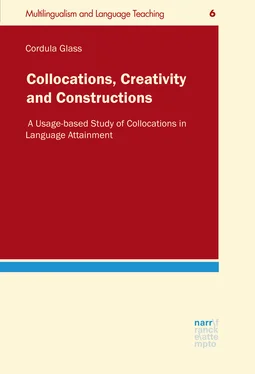



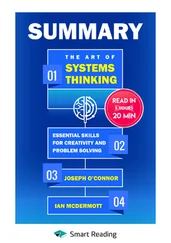

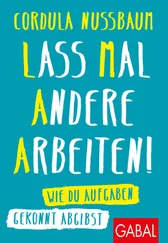

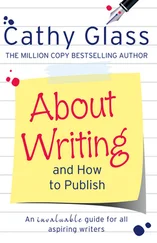

![Chade-Meng Tan - Search Inside Yourself - Increase Productivity, Creativity and Happiness [ePub edition]](/books/703803/chade-thumb.webp)


